By Captain Marshall McDonald
For more than 100 years shotgun have been equipped with “bead” sights, a simple, yet very effective sighting device. This sighting system is made up of a small round ball that is mounted on the muzzle end of the barrel, and is used without a rear sight piece.
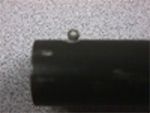 To use the bead sight, the shooter places the bead in line with the intended target and uses the flat area on the top of the receiver to insure that the weapon is leveled, in relation to the target. When properly leveled, the bead should appear to be sitting on top of the receiver.
To use the bead sight, the shooter places the bead in line with the intended target and uses the flat area on the top of the receiver to insure that the weapon is leveled, in relation to the target. When properly leveled, the bead should appear to be sitting on top of the receiver.
It should be noted that when using a flush mounted bead sight with shot shells, the shooter should aim “dead-on”, but when firing slugs, the shooter must aim 8”-10” low at 25 yards, about 18” low at 50 yards, and approximately 36” low at 100 yards.
It has long been an “old saying” that slugs rise when fired from a bead sighted barrel. This is not the case. In the absence of wings or some other device that would create lift, the slug must succumb to gravity, like everything else, and fall.
The reason that slugs impact higher than the sight would indicate, is the fact that the top of the receiver, which is acting as the rear sight (for leveling purposes) is taller than the flush mounted bead at the muzzle. This difference in height is attributed to the taper of the barrel.
Shot shells also impact slightly higher than the sight would indicate, but are usually shot at distances less than 25 yards and due to the amount of projectiles and the spread of the pattern, it is not as noticeable.
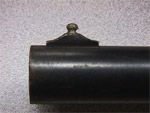 Many police shotguns that are equipped with a bead sighting system have what is referred to as a “raised bead”. This consists of a slightly taller standard bead sight that is mounted on a small rectangular block of steel that, in essence raises the bead to the level of the top of the receiver.
Many police shotguns that are equipped with a bead sighting system have what is referred to as a “raised bead”. This consists of a slightly taller standard bead sight that is mounted on a small rectangular block of steel that, in essence raises the bead to the level of the top of the receiver.
This modification eliminates the need to adjust the point of aim to distances of approximately 50 yards. Any adjustments for longer distances would be to compensate for projectile drop.
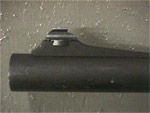 Over the past 15 or 20 years the popularity of law enforcement shotguns with “rifle type” sighting systems has greatly increased. These sights consist of a front sight that is usually a “blade” type, and is often driftable for windage adjustment.
Over the past 15 or 20 years the popularity of law enforcement shotguns with “rifle type” sighting systems has greatly increased. These sights consist of a front sight that is usually a “blade” type, and is often driftable for windage adjustment.
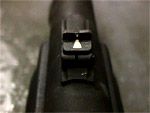 The rear sight is most frequently mounted at the rear most portion of the barrel and usually employs a “notch” or “V-shaped” indention for precise front sight alignment. Most rear sight assemblies are adjustable for windage and elevation.
The rear sight is most frequently mounted at the rear most portion of the barrel and usually employs a “notch” or “V-shaped” indention for precise front sight alignment. Most rear sight assemblies are adjustable for windage and elevation.
Rifle sights are very popular due to their adjustability and precision. These sights can be adjusted to the shooter’s choice of distance, depending on the maximum distance in which the weapon is to be employed, and for windage, so that the greatest accuracy can be obtained.
Many officers adjust the sights so that no “hold over” or aiming adjustments are needed at 100 yards, or even as far out as 150 yards.
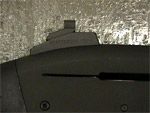 The last major “iron sight” option is known as the “Ghost Ring” sight. This system utilizes a typical front sight blade, however some may be slightly thicker that standard rifle sight blades, and an aperture style rear sight.
The last major “iron sight” option is known as the “Ghost Ring” sight. This system utilizes a typical front sight blade, however some may be slightly thicker that standard rifle sight blades, and an aperture style rear sight.
The rear sight is usually mounted at the rear of the receiver. This allows for a longer “sight radius” (the distance between the front sight and the rear sight) which aids in causing the rear sight aperture to “disappear” when the front sight is focused upon. This is where the ghost ring name comes from.
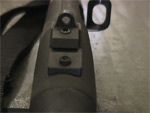 Ghost ring sights have been said to be “faster” during target acquisition and advantageous in low light conditions, due to the large rear aperture allowing more ambient light in.
Ghost ring sights have been said to be “faster” during target acquisition and advantageous in low light conditions, due to the large rear aperture allowing more ambient light in.
There are many types of electronic sighting systems available for virtually any type of weapon. I have never advocated the use of these type sights due to the fragility of electronics and the ever present Mr. Murphy. The fewer things attached to a combat weapon, the more likely you are to finish the mission with everything in one piece.


